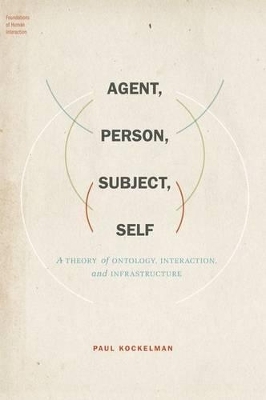
Agent, Person, Subject, Self
Oxford University Press Inc (Verlag)
978-0-19-992698-5 (ISBN)
This book offers both a naturalistic and critical theory of signs, minds, and meaning-in-the-world. It provides a reconstructive rather than deconstructive theory of the individual, one which both analytically separates and theoretically synthesizes a range of faculties that are often confused and conflated: agency (understood as a causal capacity), subjectivity (understood as a representational capacity), selfhood (understood as a reflexive capacity), and personhood (understood as a sociopolitical capacity attendant on being an agent, subject, or self). It argues that these facilities are best understood from a semiotic stance that supersedes the usual intentional stance. And, in so doing, it offers a pragmatism-grounded approach to meaning and mediation that is general enough to account for processes that are as embodied and embedded as they are articulated and enminded. In particular, while this theory is focused on human-specific modes of meaning, it also offers a general theory of meaning, such that the agents, subjects and selves in question need not always, or even usually, map onto persons. And while this theory foregrounds agents, persons, subjects and selves, it does this by theorizing processes that often remain in the background of such (often erroneously) individuated figures: ontologies (akin to culture, but generalized across agentive collectivities), interaction (not only between people, but also between people and things, and anything outside or in-between), and infrastructure (akin to context, but generalized to include mediation at any degree of remove).
Paul Kockelman is a linguistic anthropologist, with a strong area focus in Latin America, who is broadly interested in the relation between meaning, value, and information. His scholarship, developed in more than 25 articles, has focused on a broad set of interrelated topics concerning language, culture and mind. Methodologically, he draws on his empirical research to analyze relations among grammatical categories, discourse patterns, social relations, and cultural values as they unfold in both face-to-face and more mediated forms of interaction. His research has been sustained by extensive linguistic and ethnographic fieldwork, primarily among speakers of Q'eqchi'-Maya living in the cloud forests of highland Guatemala, and now more and more among scientists and engineers working on and with a variety of information technologies.
Figures ; Tables ; 1. Semiotic Ontologies ; 1. Signs, Minds, and Meaning-in-the-World ; 2. Ontology, Interaction, and Infrastructure ; 2. Biosemiosis, Technocognition, and Sociogenesis ; 1. Relations between Relations ; 2. Significance and Selection ; 3. Communication between Conspecifics ; 4. The Organization of Cognitive Processes ; 5. Framing ; 6. Artificial and Natural Selection, Sieving and Serendipity ; 7. Lawn-Mowers and Logic Gates ; 8. Relations between Relations Revisited ; 9. Networks of Interconnected Envorganisms ; 10. The Evolution and Epidemiology of Culture ; 3. Enclosing and Disclosing Worlds ; 1. The Neo-Organon ; 2. Semiotic Processes, Social Theories, and Obviated Ontologies ; 3. Social Statuses, Material Substances, and Mental States ; 4. Relatively Emblematic Indices ; 5. Semiotic Agents and Generalized Others ; 6. From Performativity to Transformativity ; 4. Residence in the World ; 1. From Being-in-the-World to Meaning-in-the-World ; 2. Heeding Affordances ; 3. Wielding Instruments ; 4. Undertaking Actions ; 5. Inhabiting Roles ; 6. Fulfilling Identities ; 7. From Acting Under a Description to Comporting Within an Interpretation ; 5. Representations of the World ; 1. Intentionality Reframed ; 2. Cognitive Representations ; 3. Discursive Practices ; 4. From Theory of Mind to the Interpretation of Signs ; 5. Intentionality and Emblemeticity ; 6. Selfhood, Affect, and Value ; 1. I Err Therefore I am ; 2. From Subjectivity to Selfhood ; 3. From Cognition to Affect ; 4. Maps, Terrains, and Travelers ; 5. From Meaning to Value
| Reihe/Serie | Foundations of Human Interaction |
|---|---|
| Zusatzinfo | 17 halftones |
| Verlagsort | New York |
| Sprache | englisch |
| Maße | 236 x 160 mm |
| Gewicht | 499 g |
| Themenwelt | Geisteswissenschaften ► Philosophie ► Metaphysik / Ontologie |
| Geisteswissenschaften ► Philosophie ► Sprachphilosophie | |
| Geisteswissenschaften ► Psychologie ► Allgemeine Psychologie | |
| Geisteswissenschaften ► Sprach- / Literaturwissenschaft ► Sprachwissenschaft | |
| Sozialwissenschaften ► Soziologie | |
| ISBN-10 | 0-19-992698-0 / 0199926980 |
| ISBN-13 | 978-0-19-992698-5 / 9780199926985 |
| Zustand | Neuware |
| Haben Sie eine Frage zum Produkt? |
aus dem Bereich


